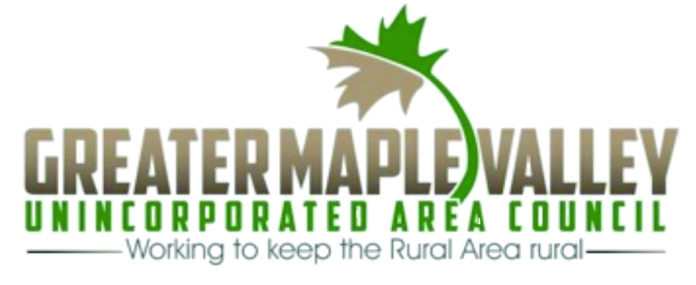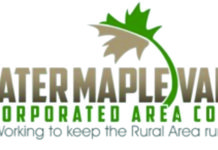On Monday, February 3, 2025, the Area Council held its Regular Monthly Meeting at the Maple Valley Fire Station and via Zoom. Major topics discussed were: (1) King County Critical Areas Ordinance Update; (2) Proposed Segale Mine above the Green River Gorge; and (3) the Greater Maple Valley/Cedar River Community Service Area Subarea Plan.
Critical Areas Ordinance (CAO) Update
Terry Lavender, Environmental Focal of the Joint Rural Team (nine organizations spread throughout King County’s Rural Area coordinated by the Area Council), discussed the ongoing CAO Update.
On December 5, 2024, the King County Executive submitted his revised Best Available Science Review and Updates Report (http://gmvuac.org/wp/wp-content/uploads/2025/02/2024-0408-BAS-Review-and-Updates-Report.pdf) to the King County Council, accompanied by a Frequently Asked Questions (http://gmvuac.org/wp/wp-content/uploads/2025/02/CAO-FAQ-120524-1.pdf) document. The King County Council has until the end of 2025 to approve a final Update that will become part of the King County Comprehensive Plan.
King County has a long history of protecting Critical Areas starting with the Sensitive Areas Ordinance in 1990, which paralleled the Basin Plans, and was preceded by extensive mapping of stream basins and wetlands.
In 2004, King County passed its first BAS and Critical Areas Ordinance, as required by the State’s Growth Management Act (GMA), which also gives some guidance about what is required. The GMA requires that both regulatory and non-regulatory measures be used to protect Critical Areas. Examples of non-regulatory are: improved mapping, monitoring, the Land Conservation Initiative, Public Benefit Rating System, flood and stormwater management plans, Best Management Practices, Farm and Forest Management Plans, restoration, and more.
The GMA requires “no net loss of Critical Area Functions.” and the science that defines and describes this is included and referenced throughout the document. It is made clear there is no approach to regulation that eliminates all risk or harm. A new requirement with this update is that special consideration must be given to anadromous fish (i.e., migrating upriver from the sea to spawn) throughout. When GMA goals conflict (like housing in unincorporated urban areas and protecting the critical areas), King County seeks to eliminate high risk and allow low to moderate risk when tradeoffs are needed. The CAO uses multiple approaches and seeks to achieve “No Net Loss” on a larger scale. Reasonable Use and Critical Area Alteration Exceptions still are allowed at the parcel and permit level. In addressing Livestock Management King County looked at the BAS and compromised between the highest level, of protection and current requirements to define buffers from rivers, streams, etc. Wetland protection is increased and climate change is considered. Vegetation in the buffer is noted as critical to a functioning wetland, so planting is encouraged especially if a buffer reduction is allowed.
King County has tried to balance the need for Critical Area protections with the needs of private property owners, recognizing there is no approach that will eliminate all risk to Critical areas when a property is developed. King County’s regulatory approach is to eliminate high risk, but recognize that moderate to low risk can be managed.
This body of regulations is immensely complicated and many of the pieces that would make it easier, like accurate maps, are still in process. Mapping of wetlands and riparian areas is funded but just starting. Other mapping is not yet funded. But mapping is not enough, as the regulations still require a site visit to identify critical areas during the permit process. Materials for the Public to use to understand Critical Areas on their property will be updated and available after the King County Council passes the CAO Update later this year.
Proposed Segale Mine
Valerie Cunningham, of the Concerned Citizens of Cumberland, discussed the proposed mining complex above the Green River Gorge: Cumberland Aggregate Mine and Asphalt Plant Project. The applicant, Segale Properties, LLC, bought the property (~1,000 ac) from King County ~10 years ago.
The proposal is for 5 mine sites and an asphalt plant. According to the applicant, “the site is generally envisioned to contain adequate product so as to last approximately 25-35 years.” The entrance and exit to the operation will be from Cumberland Kanaskat Road.
There are many issues with both the site and the proposal that concern members of the Public: impacts to the river and to water quality; traffic (nearly 700 truck trips per day on King County roads destined for SR-169 [with a ~60/40 split north vs. south]); damage to the underlying City of Black Diamond Spring; no water availability (need ~25,000 gallons of fresh water per day to run the proposed operations); impacts to BPA power towers on property; Tribal issues (fish, water quality, cultural impacts, etc.); future site reclamation; and many more.
There has yet to be a No Determination of Significance or Non-Significance issued by the King County Department of Local Services, Permitting Division. Valerie stated the Public would like an Environmental Impact Statement (EIS) triggered.
The property is zoned only for Forestry. The applicant has stated it wants to trade it for Section 16 (which is is surrounded by the property and is zoned for Forestry and Mining) owned by the WA Department of Natural Resources.
For more information please visit: https://concernedcitizensofcumberland.com/.
Subarea Plan
Subarea Planners Susan McLain and Kaitlin Harris from the King County Department of Local Services (DLS) discussed the ongoing Greater Maple Valley/Cedar River (GMV/CR) Community Service Area (CSA) Subarea Plan. A Preliminary Plan is being drafted based on community input and is expected to be ready for review in July after which drafting of the full Plan will begin and last through the end of the year.
On January 22 three Area Council committees—Environment, Growth Management, and Transportation—held separate meetings on issues and policies to be addressed in the Subarea Plan. King County Subarea Planners attended each meeting and proved pertinent Maps, Data, etc.
To continue community engagement to develop the Subarea Plan the Department of Local Services will be hosting a series of community conversations at the Hobart Community Church from 5:30-7:00PM:
•February 19 – Equity/Vision & Principles
•March 5 – Environment/Parks, Open Space, & Cultural Resources
•March 19 – Economic Development/Housing & Human Services
•April 2 – Land Use & Zoning/Services & Utilities
•April 16 – Transportation
King County subject-matter exports on each of the above topics will be present to provide informations and answer questions from members of the Public.
For more on the subarea planning process please see: Subarea Planning (https://kingcounty.- gov/so-so/dept/local-services/buildings-property/development-planning-regulations/subarea-plans). For specifics on the GMV/CR CSA Subarea Plan, please see the Area Council’s GMV/CR CSA Subarea Plan (http://gmvuac.org/gmvcr-csa-subarea-plan/) webpage.
Next Area Council Meeting
The next Area Council monthly meeting will be held Monday, March 3, 2025 from 7 – 9:30 PM at the Maple Valley Fire Station at 22225 SE 231st St (across from the KC Sheriff’s Precinct).
Meetings are held on the first Monday of the month (except for Holidays, when they are held on the second Monday). All meeting announcements, agendas, and Zoom information are posted on the Area Council’s Website (www.gmvuac.org) and local NextDoor platforms. You can also find us on our FaceBook page (https://www.facebook.com/GMVUAC/). Each meeting begins with an open Public Comment period where anyone can voice concerns, comments, etc.
Area Council Membership
Your Area Council, founded in 1978, is one of the longest continuously active local councils. It serves as an all-volunteer, locally recognized advisory body to King County on behalf of all rural unincorporated area residents living in the Tahoma School District (TSD). The Area Council, in “working to keep the Rural Area rural,” collaborates regionally with other King County Rural Area organizations through both the Joint Rural Team and its Joint Transportation Initiative.
The twelve-seat Area Council has four open seats. If you have an interest in joining, please send an e-mail to: GMVUAC (info@gmvuac.org) or attend (either in-person or virtually) a monthly meeting and express your interest. To be eligible to join the Area Council as a Member you need to live within the TSD.
Residents, even those not living within the TSD, are eligible to become Associate Members who can serve (including as Chair or Vice-Chair) on any Area Council Committee: Environment, Growth Management, Transportation, Public Relations, or Train Show. For information on each of these committees please see the Area Council’s Website (www.gmvuac.org) and use the drop-down menu under Committees.
All Monthly Meeting Summary Articles can be found on our Home page in the 2025/2024 GMVUAC Monthly Meeting Articles box or by using the drop-down menu under Correspondence.


